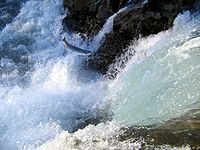
Photo from wikipedia
Understanding freshwater fish population ecology is a pre-requisite for their conservation, management, and exploitation. Many populations of cyprinids, the largest family of freshwater fish, undertake potamodromous migrations. This has important… Click to show full abstract
Understanding freshwater fish population ecology is a pre-requisite for their conservation, management, and exploitation. Many populations of cyprinids, the largest family of freshwater fish, undertake potamodromous migrations. This has important implications for the conservation and management of their stocks. Habitat and connectivity loss are the main factors threatening these stocks. The fine-scale routes (i.e., banks vs. midchannel) of cyprinid spawning migrations in generally turbid rivers are largely unknown, contrary to other taxa such as salmonids, shads, and eels. In this work, we studied the fine-scale leaping behavior of two cyprinid taxa (Luciobarbus sp., barbels) which support commercial and recreational fisheries. We used fish size and leap distance to the margin as indicative of fine-scale spawning migration routes following the river banks vs. midchannel. The results support the idea that these cyprinids migrate close to the banks, and that the larger adults migrate nearer the banks than the smaller ones. This marks a difference between cyprinids and salmonids, showing that knowledge of cyprinid migration routes can help fisheries managers develop improved, more permeable, barriers and less selective fish pass facilities. Particularly, this behavior of cyprinid species can be applied to optimize the design of fish pass facilities: first, by installing fish passes on each bank of wide rivers, where the large lateral distance may make a single facility difficult to find; and second, by using either a single wider entrance or several narrower entrances distributed over a greater distance from the margins so as to cover the more distant stretch used by the younger adults.
Journal Title: Fisheries Research
Year Published: 2018
Link to full text (if available)
Share on Social Media: Sign Up to like & get
recommendations!